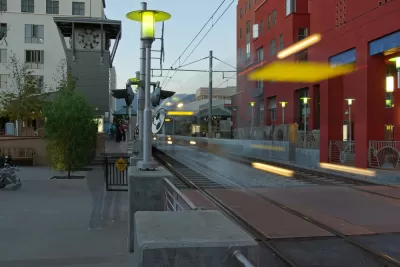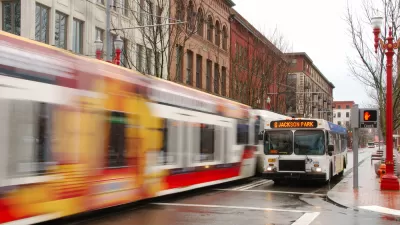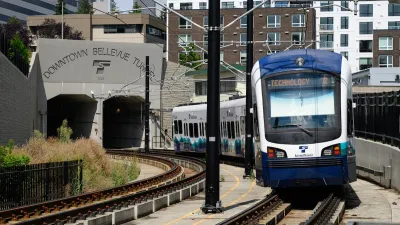The new TOD Index provides solid information on Transit-Oriented Development impact and benefits. It indicates that home values near rail stations outperform the national market, yet they are also more affordable for residents.

A new report from the TOD Index reveals three important findings for the national real estate industry and housing market:
1. The financial performance of for-sale and rental housing in thousands of neighborhoods near rail stations across the United States significantly out-performs the national housing market. Among all station typologies, Transit Oriented Developments (TODs) are the leading performer.
2. Despite the impressive financial performance of TODs, households that live in TODs spend the lowest percentage of their income on housing and transportation costs, providing $10,000 in additional annual disposable income, on average, compared to the average American household.
3. Households in TODs demonstrate the lowest vehicle ownership rates and highest rates of transit, walk, bike commuting, which has important implications for environmental sustainability.
Dr. John L. Renne, the creator of the TOD Index, stated, "TODs are performing so well in the market because they provide households with options. These options include travel choices, choices of where to eat and shop, and the option to live a lifestyle with lower impacts to the natural environment."
The report finds that TODs residents spend only 24% of their income on housing, compared with the 33% national average, and only spend 13% of their income on transportation compared with the 18% national average. Other key findings from the TOD Index include:
- The average home value in a TOD was $518 per sq. ft. compared to the Zillow Home Value Index of $149 per sq. ft. for the average home in the United States.
- Rental rates in TODs was $2.28 per sq. ft. compared to the Zillow Rent Index value of $0.89 per sq. ft. for the average rental in the U.S.
- Since the start of the economic recovery, in January 2012, TOD home values grew by 37% as compared to a 20% growth for the average American home.
- Since January 2012, rental rates grew by 18% in TODs compared to 8% growth nationally.
Renne notes, "Even though TOD homes cost more on a per square foot basis, they are smaller so the overall cost is attainable. Moreover, 72% of households in TODs are renters as compared to 33% for the nation. The barriers to rent housing is much lower than to purchase housing, so that's another dimension of housing affordability present in TODs." However, Renne cautions, "We are not building enough new housing near transit to keep up with the pace of growing demand, especially among the Millennials, so it will likely become less and less affordable in the near future."
The TOD Index methodology found that two-thirds of all rail stations across the United States are not TODs because they are not dense enough and/or not considered walkable.
Renne stated, "It should be a no brainer to promote policy to increase housing supply and promote walkability around underutilized rail stations because the government investment in the transit system has already been made. The market is speaking and Americans increasingly want to live in TODs."
* * *
The TOD Index was created by Dr. John L. Renne. Dr. Renne is the founder and Managing Director of The TOD Group, is a faculty member, Director and Associate Provost at the University of New Orleans, and is a Senior Visiting Research Associate at the University of Oxford.
FULL STORY: TOD Index

Maui's Vacation Rental Debate Turns Ugly
Verbal attacks, misinformation campaigns and fistfights plague a high-stakes debate to convert thousands of vacation rentals into long-term housing.

Planetizen Federal Action Tracker
A weekly monitor of how Trump’s orders and actions are impacting planners and planning in America.

In Urban Planning, AI Prompting Could be the New Design Thinking
Creativity has long been key to great urban design. What if we see AI as our new creative partner?

King County Supportive Housing Program Offers Hope for Unhoused Residents
The county is taking a ‘Housing First’ approach that prioritizes getting people into housing, then offering wraparound supportive services.

Researchers Use AI to Get Clearer Picture of US Housing
Analysts are using artificial intelligence to supercharge their research by allowing them to comb through data faster. Though these AI tools can be error prone, they save time and housing researchers are optimistic about the future.

Making Shared Micromobility More Inclusive
Cities and shared mobility system operators can do more to include people with disabilities in planning and operations, per a new report.
Urban Design for Planners 1: Software Tools
This six-course series explores essential urban design concepts using open source software and equips planners with the tools they need to participate fully in the urban design process.
Planning for Universal Design
Learn the tools for implementing Universal Design in planning regulations.
planning NEXT
Appalachian Highlands Housing Partners
Mpact (founded as Rail~Volution)
City of Camden Redevelopment Agency
City of Astoria
City of Portland
City of Laramie





























